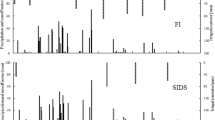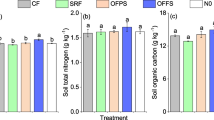Abstract
Excessive fertilizer or unseasonable fertilization ways are common in rice-cultivated regions over world, and a consequence is an environmental adverse impact resulting from substantial nutrient losses. In order to evaluate the influence of fertilization ways on nutrient losses in flooding paddy field, this work investigated the dynamic of nutrient concentrations via a short-term experiment containing single- and split-application fertilizer during main fertilization period, in the Jiangshan city, Zhejiang, China. The ponded water nutrient concentrations from fertilization plots ranged widely over the experiment: 2.8–80.9 mg L−1 for NH4+-N, 0.2–3.7 mg L−1 for NO3−-N, 1.2–215.0 mg L−1 for TN, 0.02–0.6 mg L−1 for TP, and 0.5 to 48.8 mg L−1 for TK, respectively. Applying mineral fertilizer increased immediately nutrient concentrations in ponded water and followed by a slow drop to a stead levels. The results showed a high-risk period of losses was within 3–5 days for N and 8–11 days for K following fertilization, respectively, if runoff occurred by rainstorm or drainage depending on fertilization ways. The losses risk of ponded water P after basal fertilization was negligible, but within 5 days after first topdressing was a potential pollution risk period. Compared to split fertilization, single fertilization can reduce losses risk via runoff by 66.3–67.5% for N and by 36.9–46.8% for K, respectively. However, in addition to rice yield reduction, the single application as basal fertilizer may enhance losses by NH3 volatilization, which led to a high risk of air pollution, and decrease the pH of ponded water and further soil acidification as well. Hence, the results suggested that the fertilizer split-application containing panicle fertilizer can consider as an ecological fertilization way and is suitable for rice main production region which benefit for both economic and environment despite a little increase of labor costs.






Similar content being viewed by others
Availability of data and materials
Not applicable.
References
Arienzo M, Christen EW, Quayle W, Kumar A (2009) A review of the fate of potassium in the soil-plant system after land application of wastewaters. J Hazard Mater 164(2–3):415–422. https://doi.org/10.1016/j.jhazmat.2008.08.095
Bao Shidan, Ma Jianfeng (1988) Researches on the potassium supply of soils III. The fixation and release of potassium in some different soil. J Nanjing Agric Univ 11(3):74–78 (in Chinese)
Barros R, Isidoro D, Aragüés R (2012) Irrigation management, nitrogen fertilization and nitrogen losses in the return flows of La Violada irrigation district (Spain). Agr Ecosyst Environ 155:161–171. https://doi.org/10.1016/j.agee.2012.04.004
Bjorneberg DL, Westermann DT, Aase JK (2002) Nutrient losses in surface irrigation runoff. J Soil Water Conserv 57(6):524–529. https://doi.org/10.1061/(ASCE)0733-9437(2002)128:6(404)
Bryla DR, Shireman A D, Machado RMA, Pestana M, Correia PJ (2010) Effects of method and level of nitrogen fertilizer application on soil pH, electrical conductivity, and availability of ammonium and nitrate in blueberry. VI International Symposium on Mineral Nutrition of Fruit Crops
CEPA (Chinese Environmental Protection Agency), AQSIQ (General Administration of Quality Supervision, Inspection and Quarantine of the People’s Republic of China) (2002) National surface water environmental quality standard of China (GB 3838–2002). China Standards Press, Beijing (in Chinese)
FAO (2021) Soil Nutrient Budget. Global, regional and country trends, 1961–2018. FAOSTAT Analytical Brief Series No 20. Rome
Fan QZ, Xie JC (2005) Variation of potassium fertility in soil in the long-tern stationary experiment.Acta Pedologica Sinica, 42(4):591–599. (in Chinese)
Gao SK, Shuangen Yu, Wang M, Meng J, Tang S, Ding J, Li Si, Miao Z (2018) Improving water productivity and reducing nutrient losses by controlled irrigation and drainage in paddy fields. Pol J Environ Stud 27(2):1049–1059. https://doi.org/10.15244/pjoes/76791
He ZL, Alva AK, Calvert DV, Banks DJ (1999) Ammonia volatilization from different fertilizer sources and effects of temperature and soil pH. Soil Sci 164(10):750–758. https://doi.org/10.1097/00010694-199910000-00006
Hendricks GS, Shukla S, Roka FM, Sishodia RP, Obreza TA, Hochmuth GJ, Colee J (2019) Economic and environmental consequences of overfertilization under extreme weather conditions. J Soil Water Conserv 74(2):160–171. https://doi.org/10.2489/jswc.74.2.160
Hua LL, Zhai L, Liu J, Guo S, Li W, Zhang F, Fan X, Liu H (2019) Characteristics of nitrogen losses from a paddy irrigation-drainage unit system. Agric Ecosyst Environ 285:106629. https://doi.org/10.1016/j.agee.2019.106629
Kashem MA, Singh BR (2001) Metal availability in contaminated soils I. Effects of flooding and organic matter on changes in Eh, pH and solubility of Cd, Ni and Zn. Nutr Cycl Agroecosyst 61:247–255. https://doi.org/10.1023/A:1013762204510
Lee G. Fred, Anne Jones-Lee (2005) Eutrophication (excessive fertilization). Wiley, New Jersey, pp 107–114. https://doi.org/10.1002/047147844X.sw1606
Lawlor PA, Helmers MJ, Baker JL, Melvin SW, Lemke DW (2008) Nitrogen application rate effect on nitrate-nitrogen concentration and loss insubsurface drainage for a corn-soybean rotation. Trans ASABE 51(1):83–94. https://doi.org/10.13031/2013.24229
Liu Ji, Ouyang X, Shen J, Li Y, Sun W, Jiang W, Jinshui Wu (2020) Nitrogen and phosphorus runoff losses were influenced by chemical fertilization but not by pesticide application in a double rice-cropping system in the subtropical hilly region of China. Sci Total Environ 715:136852. https://doi.org/10.1016/j.scitotenv.2020.136852
Lentz RD, Lehrsch GA (2010) Nutrients in runoff from a furrow-irrigated field after incorporating inorganic fertilizer or manure. J Environ Qual 39:1402–1415. https://doi.org/10.2134/jeq2009.0374
Liang XQ, Chen YX, Li H, Tian GM, Ni WZ, He MM, Zhang ZJ (2007) Modeling transport and fate of nitrogen from urea applied to a near-trench paddy field. Environ Pollut 150:313–320. https://doi.org/10.1016/j.envpol.2007.02.003
Liang XQ, Chen YX, Nie ZY, Ye YS, Liu J, Tian GM, Wang GH, Tuong TP (2013) Mitigation of nutrient losses via surface runoff from rice cropping systems with alternate wetting and drying irrigation. Environ Sci Pollut Res 20:6980–6991. https://doi.org/10.1007/s11356-012-1391-1
Li PF, Jianwei Lu, Hou W, Pan Y, Wang Y, Khan MR, Ren T, Cong R, Li X (2017a) Reducing nitrogen losses through ammonia volatilization and surface runoff to improve apparent nitrogen recovery of double cropping of late rice using controlled release urea. Environ Sci Pollut Res 24:11722–11733. https://doi.org/10.1007/s11356-017-8825-8
Li SM, Wang X, Qiao B, Li J, Jiamin Tu (2017b) First flush characteristics of rainfall runoff from a paddy field in the Taihu Lake watershed, China. Environ Sci Pollut Res 24:8336–8351. https://doi.org/10.1007/s11356-017-8470-2
Li Pengfei, Jianwei Lu, Wang Y, Wang S, Hussain S, Ren T, Cong R, Li X (2018) Nitrogen losses, use efficiency, and productivity of early rice under controlled-release urea. Agric Ecosyst Environ 251:78–87. https://doi.org/10.1016/j.agee.2017.09.020
Liao YL, Zheng Shengxian Lu, Yanhong YZ, Jun N, Jian X (2010) Long-term effect of fertilizer application on rice yield, potassium uptake in plants, and potassium balance in double rice cropping system. Front Agric China 4(4):406–415. https://doi.org/10.1007/s11703-010-1043-5
MacLEAN AJ (1977) Soil retention and plant removel of potassium added at an excessive rate under field conditions. Can J Soil Sci 57(3):371–374. https://doi.org/10.4141/cjss77-041
Ma Ruoya, Zou J, Han Z, Kai Yu, Shuang Wu, Li Z, Liu S, Niu S, Horwath WR, Zhu-Barker X (2021) Global soil-derived ammonia emissions from agricultural nitrogen fertilizer application: a refinement based on regional and crop-specific emission factors. Glob Change Biol 27(4):855–867. https://doi.org/10.1111/gcb.15437
McDowell Richard, Sharpley A, Brookes P, Poulton P (2001) Relationship between soil test phosphorus and phosphorus release to solution. Soil Sci 166(2):137–149
McDowell RW, Mahieu N, Brookes PC, Poulton PR (2003) Mechanisms of phosphorus solubilisation in a limed soil as a function of pH. Chemosphere 51:685–692. https://doi.org/10.1016/S0045-6535(03)00107-3
Mishra A, Ghorai AK, Singh SR (1998) Rainwater, soil and nutrient conservation in rainfed rice lands in Eastern India. Agric Water Manag 38:45–47. https://doi.org/10.1016/S0378-3774(98)00052-3
Pan YY, Koopmans GF, Bonten LTC, Song J, Luo Y, Temminghoff EJM, Comans RNJ (2015) In-situ measurement of free trace metal concentrations in a flooded paddy soil using the Donnan Membrane Technique. Geoderma 241–242:59–67. https://doi.org/10.1016/j.geoderma.2014.11.003
Qi DL, Qixia W, Zhu J (2020) Nitrogen and phosphorus losses from paddy felds and the yield of rice with different water and nitrogen management practices. Sci Rep 10:9734. https://doi.org/10.1038/s41598-020-66757-5
Saeed U, Wajid SA, Khaliq T, Zahir ZA (2017) Optimizing irrigation and nitrogen for wheat through empirical modeling under semi-arid environment. Environ Sci Pollut Res 24:11663–11676. https://doi.org/10.1007/s11356-017-8733-y
SEPA (State Environmental Protection Administration of China), (2002) Standard Methods for Water and Wastewater Monitoring and analysis, 4th ed. China Environmental Science Press, Beijing, pp. 254-281
Song JH, Ryu JH, Park J, Jun SM, Song I, Jang J, Kim SM, Kang MS (2016) Paddy field modelling system for water quality management. Irrig Drain Irrig Drain 65:131–142. https://doi.org/10.1002/ird.2034
Smith W, Grant B, Qi Z, He W, VanderZaag A, Drury CF, Vergè X, Balde H, Gordon R, Helmers MJ (2019) Assessing the impacts of climate variability on fertilizer management decisions for reducing nitrogen losses from corn silage production. J Environ Qual 48:1006–1015. https://doi.org/10.2134/jeq2018.12.0433
Stenberg M, Ulén B, Söderström M, Roland B, Delin K, Helander C-A (2012) Tile drain losses of nitrogen and phosphorus from fields under integrated and organic crop rotations. A four-year study on a clay soil in southwest Sweden. Sci Total Environ 434:79–89. https://doi.org/10.1016/j.scitotenv.2011.12.039
Sun XX, Liang X, Zhang F, Chaodong Fu (2016) A GIS-based upscaling estimation of nutrient runoff losses from rice paddy fields to a regional level. J Environ Qual 45:1865–1873. https://doi.org/10.2134/jeq2016.05.0181
Tian YH, Bin Y, Linzhang Y, Shixue Y, Zhaoliang Z (2007) Nitrogen runoff and leaching losses during rice-wheat rotations in Taihu lakw region. China Pedoshere 17(4):445–456. https://doi.org/10.1016/S1002-0160(07)60054-X
Vigovskis J, Svarta A, Jermuss A, Sarkanbarde D (2017) The changes of phosphorus and potassium in soil under different lime rates. Environ Technol Resour Proc Int Sci Pract Conf 1:301–304. https://doi.org/10.17770/etr2017vol1.2571
Wang Yu, Zhao Xu, Wang L, Zhao P, Zhu W, Wang S (2016) Phosphorus fertilization to the wheat-growing season only in a rice-wheat rotation in the Taihu Lake region of China. Field Crop Res 198:32–39. https://doi.org/10.1016/j.fcr.2016.08.025
Wang GL, Zishi Fu, Chen G, Zou G, Song X, Liu F (2018) Runoff nitrogen (N) losses and related metabolism enzyme activities in paddy field under different nitrogen fertilizer levels. Environ Sci Pollut Res 25:27583–27593. https://doi.org/10.1007/s11356-018-2823-3
Wang J, Penghao Fu, Wang F, Fahad S, Mohapatra PK, Chen Y, Zhang C, Peng S, Cui K, Nie L, Huang J (2019) Optimizing nitrogen management to balance rice yield and environmental risk in the Yangtze River’s middle reaches. Environ Sci Pollut Res 26:4901–4912. https://doi.org/10.1007/s11356-018-3943-5
Yang R, Tong J, Hu BX, Li J, Wei W (2017) Simulating water and nitrogen loss from an irrigated paddy field under continuously flooded condition with Hydrus-1D model. Environ Sci Pollut Res 24(4):15089–15106
Zhang ZJ, Yao J, Wang Z, Xin Xu, Lin X, Czapar GF, Zhang J (2011) Improving water management practices to reduce nutrient export from rice paddy fields. Environ Technol 32(2):197–209. https://doi.org/10.1080/09593330.2010.494689
Zhao Xu, Yang Zhou Ju, Min SW, Shi W, Xing G (2012) Nitrogen runoff dominates water nitrogen pollution from rice-wheat rotation in the Taihu Lake region of China. Agr Ecosyst Environ 156:1–11. https://doi.org/10.1016/j.agee.2012.04.024
Zhang SQ, Shaomin H, Shengwei N, Guo doudou, Lin Shan, (2014) Effects of long-term fertilization on potassium uptake of summer maize and potassium dynamics of fluvo-aquic soil. J Plant Nutr Fertil 20(1):56–63. https://doi.org/10.11674/zwyf.2014.0107(inChinese)
Zhang YF, Liu H, Guo Z, Zhang C, Sheng J, Chen L, Luo Y, Zheng J (2018) Direct-seeded rice increases nitrogen runoff losses in Southeastern China. Agric, Ecosyst Environ 251(1):149–157. https://doi.org/10.1016/j.agee.2017.09.022
Zhan XY Z, Qingwen Z, Hui Z, Hussain HA, Shaaban M, Zhengli Y (2020) Pathways of nitrogen loss and optimized nitrogen management for a rice cropping system in arid irrigation region, northwest China. J Environ Manage 268:110702. https://doi.org/10.1016/j.jenvman.2020.110702
Zhang YF, Hao Wu, Yao M, Zhou J, Kaibin Wu, Minpeng Hu, Shen H, Chen D (2021) Estimation of nitrogen runoff loss from croplands in the Yangtze River Basin: a meta-analysis. Environ Pollut 272:116001. https://doi.org/10.1016/j.envpol.2020.116001
Funding
The research was supported by science and technology projects (JS2021D005) in Jiangshan City, Zhejiang province, China.
Author information
Authors and Affiliations
Corresponding author
Ethics declarations
Conflict of interest
The author declare that they have no conflict of interest.
Ethical approval
Not applicable.
Consent to participate
Not applicable.
Consent to publish
Not applicable.
Rights and permissions
Springer Nature or its licensor (e.g. a society or other partner) holds exclusive rights to this article under a publishing agreement with the author(s) or other rightsholder(s); author self-archiving of the accepted manuscript version of this article is solely governed by the terms of such publishing agreement and applicable law.
About this article
Cite this article
Jiang-ming, Z. Improving fertilization practices to reduce the potential of nutrient loss from rice paddy fields. Paddy Water Environ 21, 115–126 (2023). https://doi.org/10.1007/s10333-022-00917-3
Received:
Revised:
Accepted:
Published:
Issue Date:
DOI: https://doi.org/10.1007/s10333-022-00917-3




